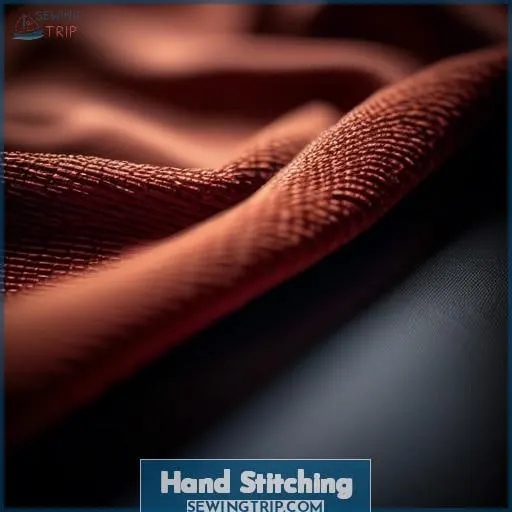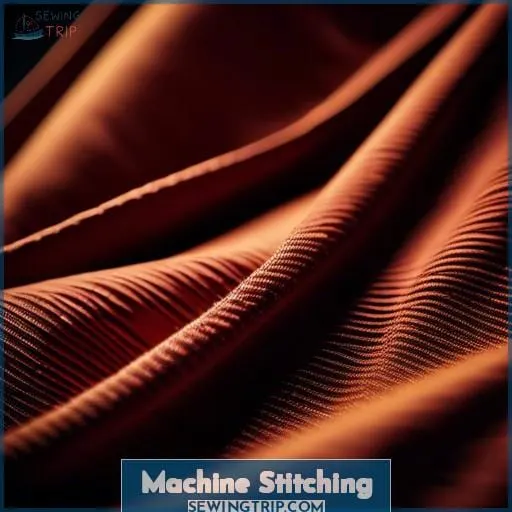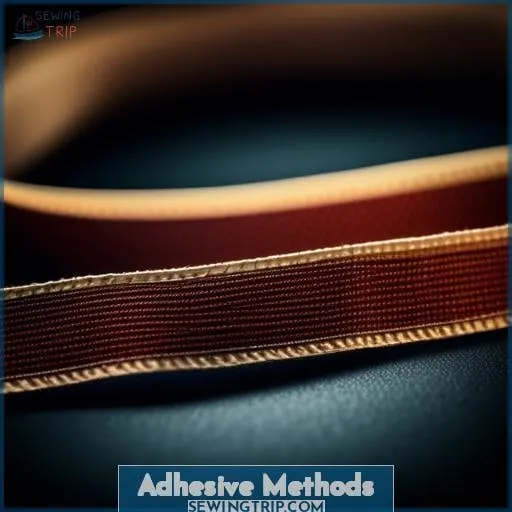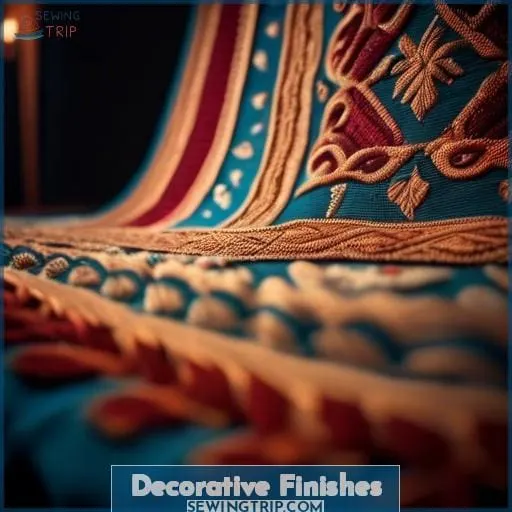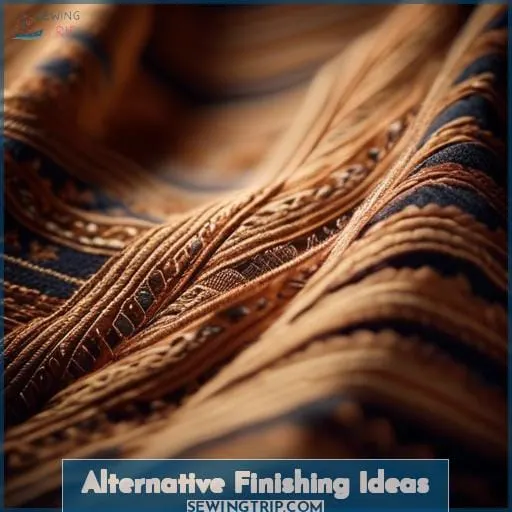This site is supported by our readers. We may earn a commission, at no cost to you, if you purchase through links.
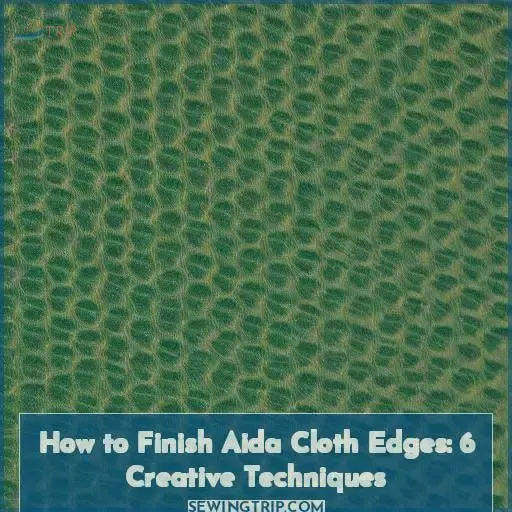 Discover how to expertly finish Aida cloth edges with these six creative techniques, ensuring your cross-stitch projects are not only secure but also aesthetically pleasing.
Discover how to expertly finish Aida cloth edges with these six creative techniques, ensuring your cross-stitch projects are not only secure but also aesthetically pleasing.
Whether you’re a seasoned stitcher or new to the craft, these methods will elevate your work, providing a polished look and preventing fraying.
Dive into the world of hand and machine stitching, adhesive applications, and decorative finishes to find the perfect edge-finishing style that resonates with your creative vision.
Table Of Contents
Key Takeaways
- Utilize a blanket stitch along the folded edge of the Aida cloth to prevent fraying and add a decorative touch.
- Apply bias tape binding to encase the raw edges for a neat finish that also prevents fraying.
- Consider using iron-on adhesives like Wonder-Under for a no-sew option that secures the edges and adds durability.
- For a decorative and functional finish, turn the Aida cloth into a pillow or attach it to a sturdy backing like cardboard or chipboard.
Hand Stitching
When finishing the edges of Aida cloth, hand stitching offers a personalized and secure method. Techniques like the whip stitch and blanket stitch not only prevent fraying but also add a neat, decorative touch to your project.
Whip Stitch
To finish the edges of Aida cloth with a whip stitch, you’ll need to select the right tools and execute the stitch with care.
- Choose a needle size that matches the weight of your thread and the weave of your Aida cloth.
- Pick thread types and colors that complement your embroidery project.
- Begin the whip stitch by entering the fabric from the same direction for each stitch, wrapping the thread around the edge.
- Add embellishments like beads or lace for a decorative touch if desired.
This technique not only prevents fraying but also gives your cross stitch piece a polished look.
Blanket Stitch
When transitioning from the whip stitch to the blanket stitch, you’re stepping up your finishing game.
Think of the blanket stitch as the Swiss Army knife in your sewing kit. It’s not just about preventing fraying; it’s about adding a dash of flair to your embroidery fabric.
With a decorative thread or colorful floss, this stitch transforms the mundane task of finishing edges of aida cloth into an opportunity for creativity.
Whether you’re crafting cross stitch bookmarks or bordering a masterpiece, the blanket stitch offers both protection and pizzazz.
It’s like giving your fabric a tight, reassuring hug with a stylish twist. So, grab your binding tape and edging thread, and let’s make those edges not just secure, but spectacular!
Hemming With Hand Stitches
After mastering the blanket stitch, you’re ready to dive into hemming with hand stitches. It’s a classic technique that’ll give your needlepoint or cross stitch fabric a polished look.
- Start with a whip stitch or blanket stitch to secure the edge.
- Fold the edge into a hem for a neat finish.
- Use fray check as a backup to keep stitches in place.
- Employ hand embroidery skills to add a decorative touch.
- Remember, stitching on clothing often uses similar hemming methods.
You’ll be stitching like a pro in no time, and your cross stitch projects will thank you for that extra touch of durability and style!
Machine Stitching
When finishing the edges of Aida cloth for your cross-stitch projects, machine stitching offers a quick and effective solution.
You can use a zig-zag stitch or an overlock (serger) stitch to secure the edges, preventing fraying and ensuring a neat finish.
Zig-zag Stitch
When it comes to finishing the edges of your Aida cloth, the zigzag stitch is your trusty sidekick. This stitch, versatile and strong, is perfect for taming those frayed edges, ensuring your masterpiece stays pristine from start to finish.
But, before you dive in, let’s talk settings. Your sewing machine is more than just a tool; it’s your partner in creativity.
| Setting | Purpose | Recommended |
|---|---|---|
| Width | Seam Sealant | 3.0 |
| Length | Fraying Prevention | 3.0 |
| Tension | Fabric Type | Adjustment Needed |
Overlock (serger) Stitch
To prevent fraying and finish the edges of Aida cloth, an overlock (serger) stitch is a fantastic choice.
- Choose the right serger thread that complements your fabric.
- Adjust the tension to accommodate the fabric thickness and avoid puckering.
- Select a needle type that’s appropriate for the weight of your Aida cloth.
- Set a suitable stitch length to ensure a secure edge without over-tightening.
Adhesive Methods
When finishing the edges of Aida cloth, adhesive methods offer a quick and effective solution.
Iron-on adhesives, such as Wonder-Under, provide a no-sew option that secures the fabric edges, preventing fraying and adding durability to your project.
This technique is particularly useful for creating patches or appliqués from your cross-stitch work, allowing for easy application to various surfaces.
Iron-on Adhesives (e.g., Wonder-Under)
When it comes to finishing the edges of your Aida cloth, iron-on adhesives like Wonder-Under offer a slick, no-fuss solution that’s as easy as pie.
Imagine you’re a magician, and your iron is your wand. With a swift flick (and no steam, please), you’re bonding those frayed edges faster than you can say abracadabra.
But here’s the kicker: it’s not just about stopping the fray; it’s about opening a world of creative possibilities.
Dreaming of fringed edges that don’t unravel? Wonder-Under’s got your back. It’s like giving your project a superpower, where the only limit is your imagination.
So, grab that iron, and let’s turn those edges from frumpy to fabulous.
Decorative Finishes
When finishing the edges of Aida cloth, adding a decorative touch not only enhances the appearance but also provides a practical solution to prevent fraying.
Bias tape binding and piping along the edge are two creative techniques that combine both aesthetic appeal and functionality, offering a polished finish to your needlework projects.
Bias Tape Binding
Bias tape binding is your secret weapon for a polished finish on aida cloth edges.
Whether you’re crafting cross stitch masterpieces or charming bookmarks, bias tape offers a neat solution.
Choose between single fold for a flat edge or double fold for a wraparound charm.
Folding and attaching bias tape can be a breeze, but remember, it’s all in the details.
Double-check your bias tape selection, ensuring it complements your project’s aesthetic.
When you’re ready, fold that bias tape with precision, and attach it with confidence.
Your bookmarks will thank you, and your cross stitch will stand out with those impeccably finished edges.
Piping Along the Edge
To add a dash of panache to your Aida cloth edges, why not try piping? It’s like giving your cross stitch project a snazzy suit!
Piping can come in a kaleidoscope of colors, adding a pop to your handiwork. You’ll need the right tools—piping cord and a zipper foot for your machine. Choose materials that complement your fabric and won’t fray, like cotton or polyester.
If you’re crafting small bags or bookmarks, piping gives that professional touch.
Alternative Finishing Ideas
If you’re looking to give your finished Aida cloth a new life beyond the hoop, consider turning it into a pillow. This method not only enhances the presentation of your work but also protects the edges from fraying.
Another option is attaching it to cardboard or chipboard for display. This method also serves to enhance the presentation of your work and provides protection against fraying.
Turning Into a Pillow or Cushion
Turning your finished cross-stitch into a pillow or cushion is like giving your artwork a cozy home. Imagine wrapping your embroidery in a hug—this is what you do when you transform it into a plush accessory.
First, pick a fabric that complements your design; think of it as choosing the perfect outfit for your masterpiece. Whether you opt for a vibrant pattern or a solid hue, ensure it sings in harmony with your stitches.
Next, consider the shape of your cushion. It doesn’t have to be square; be bold and maybe go for a heart or a star, echoing the creativity of your cross-stitch.
As for the stuffing, it’s the secret sauce that brings your pillow to life, making it plump and inviting. Don’t forget the decorative embellishments! A lace trim or a row of buttons can add that extra oomph, turning a simple cushion into a statement piece.
And if you’re feeling adventurous, why not explore the realms of the wheel of time cross stitch bookmarks or cross stitch pin cushions? These smaller projects are perfect for experimenting with pinked edges and other ways to make bookmarks, offering a playground for your creativity.
So, grab your needle and thread, and let’s turn that cross-stitch into something you can snuggle with!
Attaching to Cardboard or Chipboard
When transitioning from the cozy idea of transforming your Aida cloth into a pillow or cushion, consider the equally creative avenue of attaching it to cardboard or chipboard. This method not only gives your project a sturdy backing but also opens up a plethora of decorative possibilities.
- Gluing to Wood: Secure your masterpiece with fabric glue for a bond that’s both strong and seamless.
- Edging with Leather: For a touch of sophistication, consider framing your work with leather edges.
- Sewing onto Fabric: Attach your Aida cloth to a fabric background to create a layered effect.
- Creating a Frame: Use cardboard or chipboard to craft a custom frame, giving your project the perfect finishing touch.
This approach not only secures your work but also elevates it, turning simple stitches into a statement piece.
Frequently Asked Questions (FAQs)
Can I use regular scissors instead of pinking shears to prevent fraying?
You can use regular scissors instead of pinking shears, but they won’t prevent fraying as effectively.
Pinking shears create a zigzag pattern that inhibits fraying, while straight cuts don’t.
How does fabric type affect fraying and finishing methods?
Fabric type is the Achilles’ heel of fraying; like a delicate dance, each fabric has its rhythm.
Woven fabrics often fray, needing stitches or adhesives, while knits, like a loyal friend, rarely betray with frays, simplifying finishing methods.
Is there a natural method to prevent Aida cloth from fraying without using adhesives?
To keep your Aida cloth from fraying without reaching for the glue, grab your sewing kit.
A simple whip stitch or blanket stitch around the edges does the trick.
It’s a bit of a time investment, but think of it as a warm-up exercise for your main stitching event.
Can I use household items as an alternative to commercial fray check products?
Yes, you can use household items like clear nail polish or fabric glue as alternatives to commercial fray check products.
Just remember to test on a scrap first.
How does the size of the Aida cloth affect the choice of edge finishing method?
The size of your Aida cloth directly influences your edge finishing method.
Larger pieces might lean towards machine stitching for speed, while smaller ones are perfect for detailed hand finishes.
Conclusion
With a needle or machine at your side, you’ve got all you need to masterfully finish the edges of Aida cloth.
Whether you choose the elegance of hand stitches, the strength of machine seams, or the simplicity of adhesives, your cross-stitch projects will stand out with a professional touch.
Don’t shy away from decorative flourishes like bias tape or piping to add that extra flair.
Now, go forth and let your finished edges be as remarkable as your stitching artistry.

